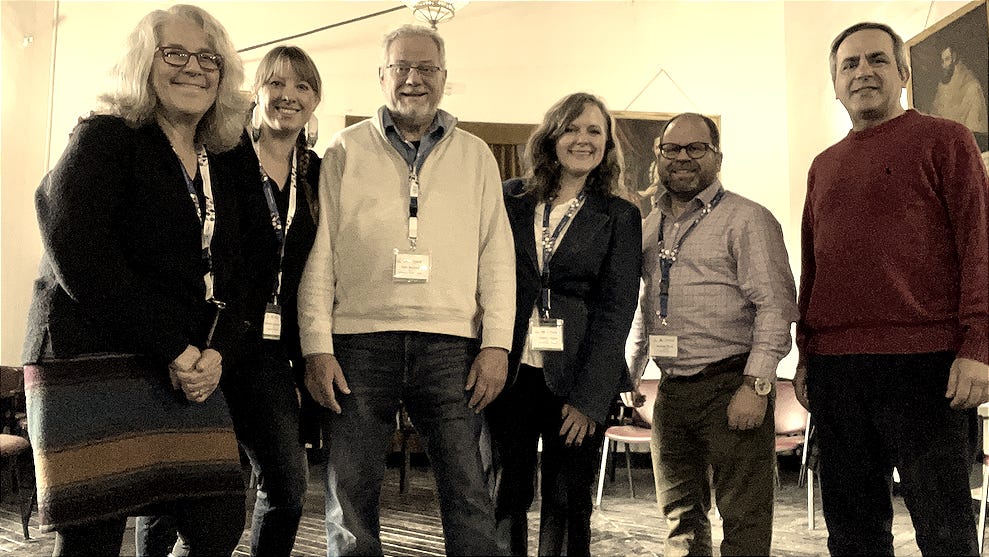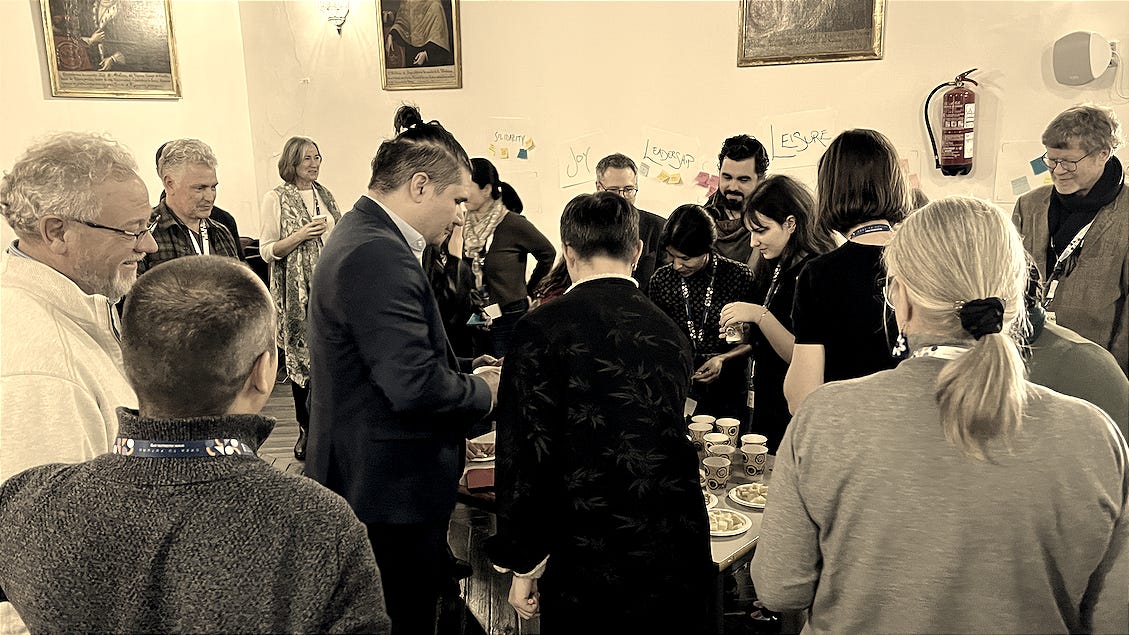Democracy as a Collective Creation
What happened when a group of academics stopped talking and started playing
Last year I accepted an invitation to speak at the 48th Annual Social Theory, Politics and the Arts Conference which took place December 12-15 in Osuna, Spain. Scholars Tom Borrup, Andrew Zitcer, Susan Booth, Harry Waters Jr., Rui Cepeda, Joanna Taylor and I co-led a session called Democracy as Creative Practice, animating ideas from the recently published book of the same title in which I co-authored a chapter with my wonderful research partner and colleague the late Diane Ragsdale called ‘Remaking Worlds and Ourselves: Aesthetic Strategies for a Culture of Democracy’.
Our proposal was to present a discussion panel as is the convention at such events. However, after some consideration, we decided to take a less typical approach. Instead, we designed our “panel” as a participatory improvisational score. The “score” was a set of instructions that set out to support a collective process of creation. What better way to illustrate how creative practice can facilitate democracy than by simply putting it in action.
A term used in improvisational practice, a score is a set of instructions that supports collective play. It acts as a guide, providing some structure, without pre-determining the outcome. What is created relies on the contributed actions of the players. Some might consider it akin to a structured democracy.
The session was tightly timed (a feature of the score) where each segment offered new forms of collective engagement framed around different sections of the book.
It went like this:
Welcome and Arrival: Why are we here?, led by Andrew (8’)
Field notes, led by Shannon (2’)
A Cacophony of Questions, led by Harry (5’)
First Action: Tuning into Expansive Ways of Knowing, led by Shannon (10’)
First Exploration: Civic Spaces, led by Johanna (10’)
Rest and Digest, led by Shannon (1’)
Next Explorations (a duet): Learning Environments and Aesthetic Strategies, led by Susan and Rui (with a surprise)
Rest and Process, led by Harry (2-3’)
Next Action: Collective Sense-making, led by Harry (10’)
Final Ritual: A Summary in the form of a toast, led by Tom (5’)
This structure allowed us to incorporate moments of inquiry, discussion, rest, embodied practice, collective creation, imagination and performance making. Through these interventions, we explored the book’s themes of creative place-making, learning environments, aesthetic strategies and civic processes. We practiced democracy together, using our creative capacities.
Much to my delight, the room full of academics was vibrating with energy. I was reminded of how artists intentionally shape space energetically, moving a group from cautious curiosity toward boisterous participation. Artists know that how people feel throughout the event becomes paramount to what they contribute and how they perceive the quality and relevance of their experience. Creating opportunities for people to express, to make connections, to make sense, to have time to process and digest, to rest, to ask questions, to learn from each other - these are the ingredients of co-creation and the elements of a productive democracy where all are participating in the making of the whole.
When I think about the many community gatherings, conferences, and learning spaces I’ve been a part of in my life, I am struck by how seldom co-creation was prioritized as an organizing principle. Too often knowledge is treated as an object rather than a process. While we all carry knowledge that grows from study or lived experiences, treating knowledge as something we consume prevents us from engaging with knowledge as a living, relational process.
When democracy is beautiful, it is the outcome of a continuous unfolding, contingent on contributions made by each and by all in the community.
Processes of creative exchange, like through an improvisational score, provide opportunities for our default ways of relating to become visible and transgressed, imagined differently, and experimented with as trust and connection builds. When co-creation starts to take shape, we simply become aware that a world is also taking shape, and that our individual contributions matter to that world.
When we see ourselves reflected in what is created, we find it meaningful.
To make new worlds together, the environment itself must nurture qualities in us that help us feel reasonably safe (free from harm), connected, and mutually open to possibility. In this kind of a generative dynamic, we feel able to give voice to our needs and desires, while also inviting an awareness and responsiveness to what is needed to support the collective. However, when the environment defaults to familiar organizing principles (a panel discussion at an academic conference), we are also likely to default to familiar ways of relating (panelists talk, attendees listen and maybe ask some questions at the end). Knowledge flows from the ‘expert’ panelists to the curious attendees, never exploring how knowledge might expand by more intentionally animating the relationships in the room.
Transgressing familiar norms gives us and others permission to expand into new possibilities. In Teaching to Transgress, bell hooks reminds us that “our capacity to generate excitement is deeply affected by our interest in one another, in hearing one another’s voices, in recognizing one another’s presence.” She encourages education as a practice of challenging boundaries, in service of a truly democratic society.
Creative practice offers myriad ways to transgress generatively, to organize cooperatively, and to forge pathways to the unforeseen. Importantly, we want to do this through the cultivation of trust and mutual care, through generous reciprocity, by engaging with a diversity of aesthetic values, and by balancing individual interests with collective aims in the process of creation. When these practices are put in action, a healthy and just democracy becomes a natural outcome.





